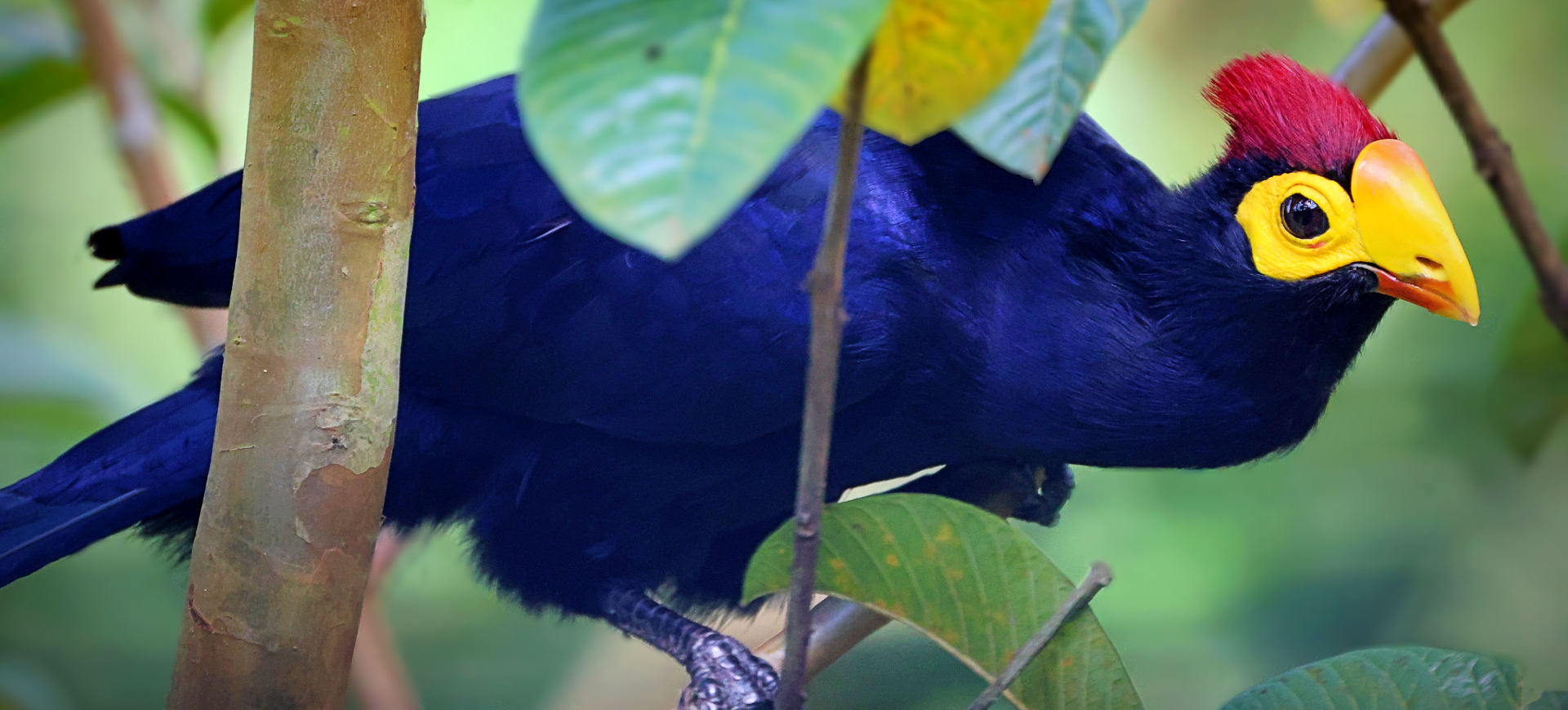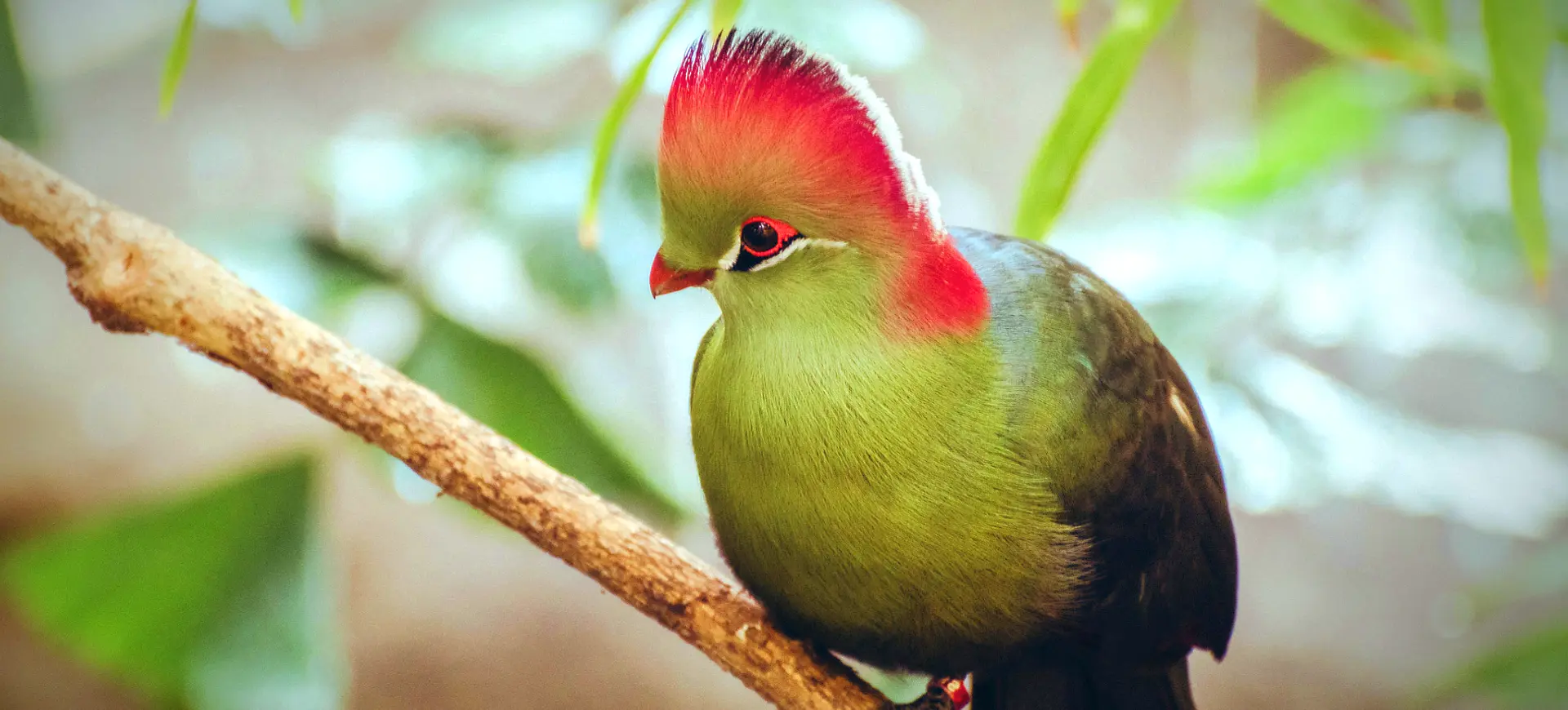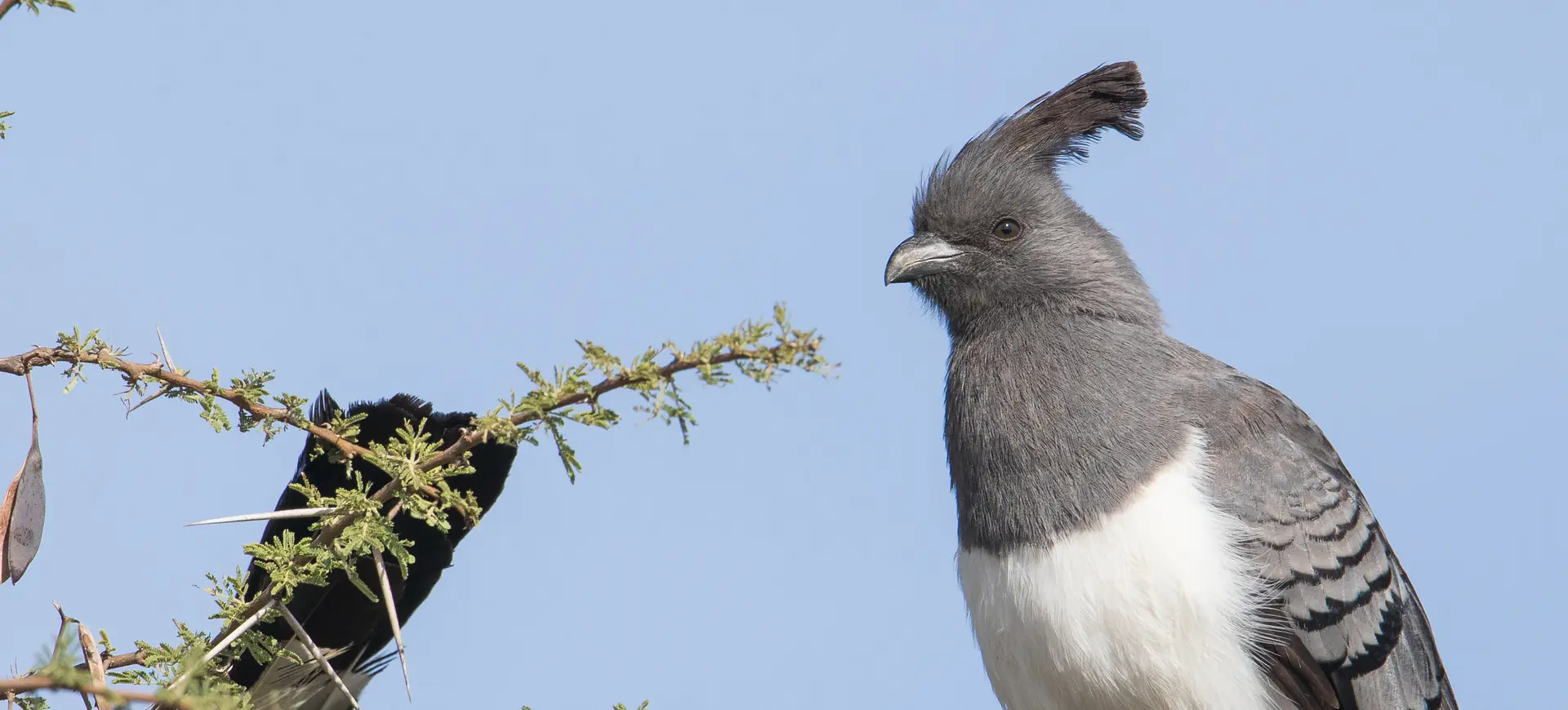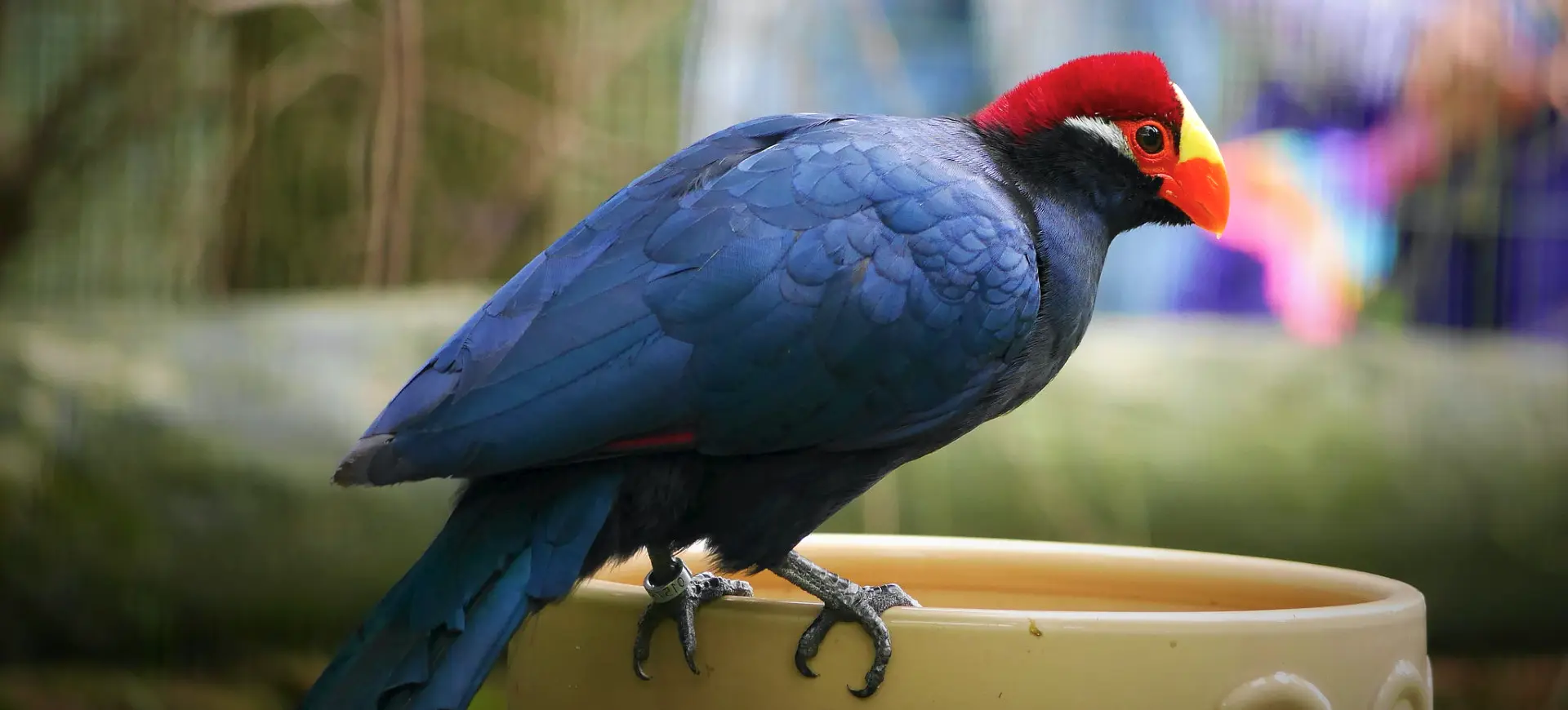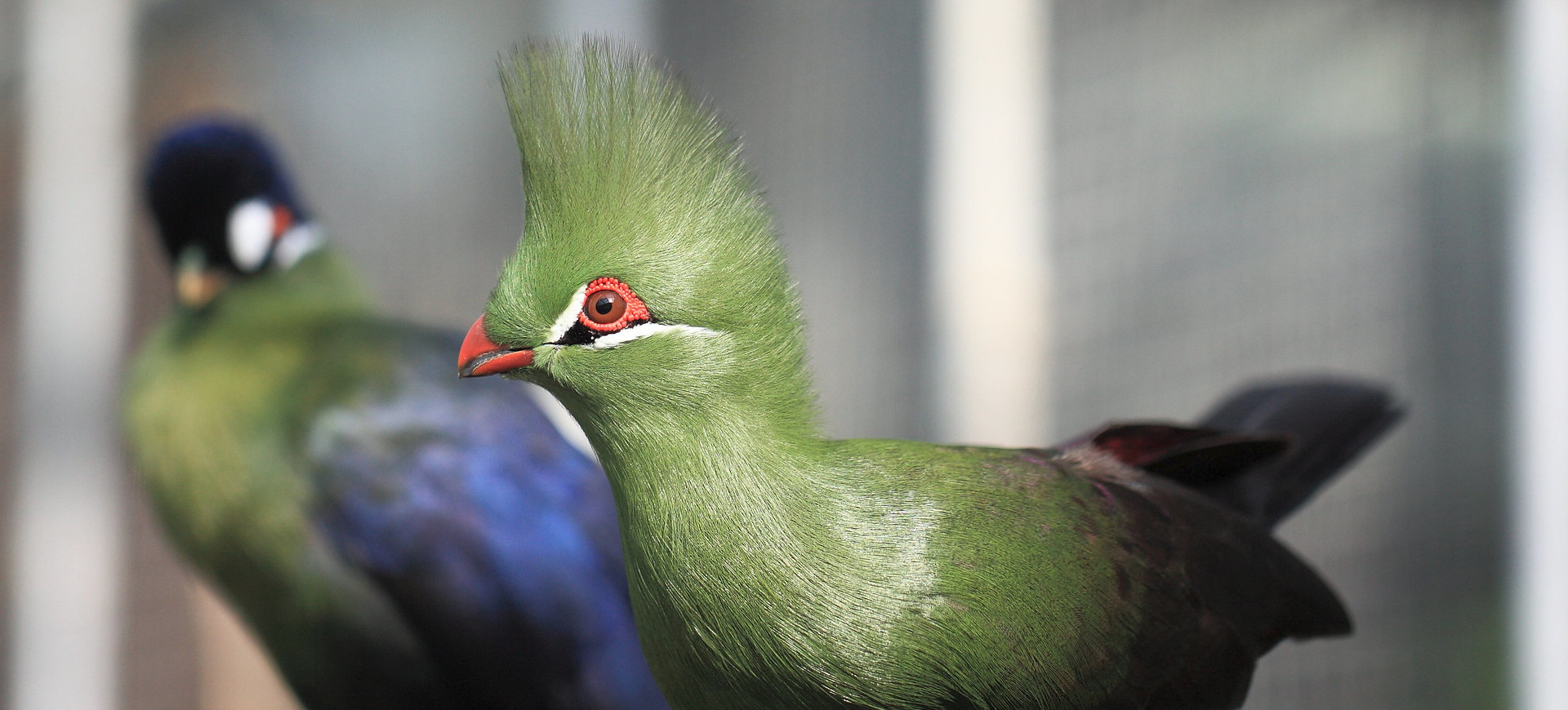Overview
The White-cheeked Turaco (Tauraco leucotis) is a vibrant and striking bird native to the highland forests of Ethiopia and surrounding areas. This species is part of the Turaco family, birds known for their bright colors and unique pigments. The White-cheeked Turaco is particularly noted for its deep green and blue plumage, contrasted with its distinctive white cheek patches and a red ring around the eye, making it a visually captivating species. They are arboreal, spending most of their time in the treetops foraging for fruits, leaves, and flowers, which constitute their primary diet.
These birds play a crucial role in their ecosystems as seed dispersers, aiding in the propagation of many forest plant species. The White-cheeked Turaco is a social bird, often found in small groups, and is known for its loud and melodious calls, which can be heard echoing through the forests they inhabit. They exhibit strong territorial behavior, especially during the breeding season when their vocalizations become more frequent. Despite their bright colors, they can be surprisingly difficult to spot in their natural habitat’s lush, green canopy.
The White-cheeked Turaco’s adaptability to various forest habitats has helped maintain stable populations, though habitat destruction poses a constant threat. Conservation efforts focus on preserving their natural habitats and ensuring sustainable environments for these and other forest-dwelling species. These turacos are also popular in aviculture and admired for their beauty and unique characteristics. However, ensuring they thrive requires knowledge of their dietary, social, and environmental needs, highlighting the importance of responsible pet ownership and conservation practices.
Taxonomy
Kingdom
Phylum
Class
Order
Family
Genus
Species
Sub Species
Type
Physical Description:
The White-cheeked Turaco is medium-sized, typically measuring 16-17 inches (40-43 cm) in length from beak to tail, with both males and females sharing similar dimensions and plumage colors, making sexual dimorphism minimal in this species. They weigh approximately 7-9 ounces (200-255 grams), showcasing a slender and agile build adapted for life in the treetops. Their feathers possess a unique pigment called turacin, responsible for the vibrant red color in their wings, which is not found in any other bird family except the turacos. The combination of their green body, white cheeks, and striking red wing patches, visible during flight, makes them one of the most distinctive birds in their natural environment.
Both sexes have a crest of feathers on their head, which can be raised or lowered depending on their mood or social interactions. Their strong, zygodactyl feet, with two toes facing forward and two backward, allow them to grasp branches securely as they move through the trees. The bright red eye ring adds to their expressive appearance, making them quite the character among forest dwellers. Despite their colorful plumage, White-cheeked Turacos blend remarkably well into their leafy surroundings, a testament to the effectiveness of their natural camouflage.

Lifespan: Wild: ~10 Years || Captivity: ~12 Years

Weight: Male & Female: 7-9 oz (200-255 g)

Length: Male & Female: 16-17 in (40-43 cm)

Wingspan: Male & Female: 6-7 in (15-18 cm)
Characteristic:
Native Habitat:
The White-cheeked Turaco inhabits Ethiopia’s montane forests and woodland areas and parts of Sudan, thriving in regions rich in dense foliage and fruit-bearing trees. They are adapted to a life spent mostly in the trees, showing a preference for high-altitude forests where they can be found from 1,800 to 3,000 meters (5,900 to 9,800 feet) above sea level. These habitats provide the necessary cover and food resources for the White-cheeked Turaco and opportunities for nesting and social interaction. The preservation of these forested areas is crucial for the survival of the White-cheeked Turaco, highlighting the importance of habitat conservation efforts in their native regions.
Deforestation and habitat degradation pose a significant threat to the White-cheeked Turaco, as it does to many forest-dwelling species. Conservation initiatives that focus on protecting and restoring their natural habitats are key to ensuring the continued survival of these birds. The White-cheeked Turaco’s dependence on specific habitat types makes them vulnerable to environmental changes, underscoring the need for sustainable environmental practices. Protected areas and national parks within their range play a vital role in conserving the biodiversity of these regions, offering a refuge for the White-cheeked taco and other endemic species.
Biomes:
WWF Biomes:
Biogeographical Realms:
Continents:
Countries:
Diet:
Diet & Feeding Habits:
White-cheeked Turacos are primarily frugivorous, with a diet that consists largely of fruits, supplemented by leaves, flowers, and occasionally insects. They play a significant role in their ecosystems as seed dispersers, consuming fruit whole and later excreting the seeds far from the parent tree, thus aiding in forest regeneration. In the wild, they forage in the canopy, using their agile movements and strong bills to pluck fruits and foliage. Captive White-cheeked Turacos require a diet that mimics their natural feeding habits, consisting of various fresh fruits and vegetables, to maintain their health and vibrant plumage.
The quality and variety of their diet can significantly impact their health, emphasizing the importance of nutritional care in captivity. These birds are known to be particularly fond of figs and berries, which constitute a major part of their diet in the wild. Ensuring access to clean water is crucial for their well-being, as is the case with all avian species. Adapting their diet in captivity to include specially formulated bird pellets can provide additional nutrients necessary for their health.
Mating Behavior:
Mating Description:
White-cheeked Turacos are monogamous, with pairs forming strong bonds for several breeding seasons. During the breeding season, males perform elaborate displays, including loud calls and aerial acrobatics, to attract females and defend their territory. Nesting typically occurs in trees, where the pair constructs a platform nest from twigs and leaves. Both parents share responsibilities in incubating the eggs and raising the young, showcasing parental care and cooperation.
The breeding season is closely tied to the availability of food, ensuring that there is ample nutrition for the chicks. White-cheeked Turacos lay 2-3 eggs per clutch, which hatch after an incubation period of approximately 21-24 days. The chicks are altricial, requiring several weeks of care before being ready to fledge. Protecting nesting sites and preserving food resources are critical for the reproductive success of the White-cheekedtacoo, highlighting the importance of habitat conservation in their breeding areas.
Reproduction Season:
Birth Type:
Pregnancy Duration:
Female Name:
Male Name:
Baby Name:
Social Structure Description:
White-cheeked Turacos are social birds, often found in pairs or small family groups, especially outside the breeding season. They exhibit strong territorial behavior, vigorously defending their feeding and nesting areas against intruders. Social interactions within groups include a range of vocalizations and visual displays, which maintain group cohesion and communicate threats or opportunities. The cooperative nature of breeding, with both parents involved in nest defense and chick rearing, highlights the importance of social bonds in the species’ reproductive success.
Understanding the social behavior of White-cheeked Turacos can provide insights into their ecological needs and the importance of protecting their social environments. Reserving suitable habitats supports White-cheeked Turaco populations’ social structure and ecological dynamics. Research into the social interactions and communication of White-cheeked Turacos can inform conservation strategies, ensuring the protection of vital social and feeding habitats. Conservation efforts that maintain the social integrity of White-cheeked Turaco populations are essential for sustaining the ecological balance of montane forest ecosystems.
Groups:
Conservation Status:
Population Trend:
The White-cheeked Turaco is classified as Least Concern by the IUCN Red List, indicating that it currently faces no immediate threat of extinction. However, localized declines have been observed where habitat destruction and degradation are prevalent. Conservation efforts focused on preserving and restoring montane forest habitats are crucial for ensuring the continued stability of White-cheeked Turaco populations. Monitoring and research are essential for understanding the species’ population dynamics and the effectiveness of conservation strategies.
The adaptability of the White-cheeked Turaco to different environments has been key to its survival, but ongoing habitat degradation threatens this resilience. Conservation initiatives that include habitat protection, sustainable land-use practices, and community engagement can support the conservation of the White-cheeked Turaco. Public education and awareness campaigns can raise the profile of the White-cheeked Turaco and the importance of wetland conservation. Collaborative efforts between conservation organizations, governments, and local communities are essential for effectively protecting the White-cheeked Turaco and its habitat.
Population Threats:
The main threats to the White-cheeked Turaco include habitat loss due to deforestation for agriculture, logging, and development. Habitat fragmentation isolates populations, reducing genetic diversity and limiting access to essential resources such as food and nesting sites. Climate change poses an additional threat by altering the distribution and availability of fruiting trees, impacting the birds’ food sources and nesting sites. The illegal pet trade also affects some populations, posing a risk to their wild numbers.
Conservation measures must address these threats through habitat protection, promoting sustainable agricultural practices, and managing water resources. Efforts to reduce the impact of the pet trade and implement eco-friendly farming techniques can benefit White-cheeked Turacos and other wildlife. Legal protections for forest areas and enforcing environmental regulations are also crucial for safeguarding the habitats of the White-cheeked Turaco. Engaging farmers and landowners in conservation initiatives can help mitigate the impacts of agriculture on White-cheeked Turaco populations and their habitats.
Conservation Efforts:
Conservation initiatives for the White-cheeked Turaco focus on protecting and restoring montane forest habitats, which are crucial for their survival. The designation of protected areas that encompass key habitats has been instrumental in conserving White-cheeked Turaco populations. Community-based conservation programs that involve residents in habitat management and protection can enhance the effectiveness of conservation efforts. Environmental education programs to raise awareness of the importance of montane ecosystems can foster support for conserving the White-cheeked Turaco and its habitat.
Research and monitoring activities are essential for assessing the White-cheeked Turaco’s conservation status and the montane ecosystems’ health. Sustainable water management practices are key to maintaining the ecological integrity of forests, benefiting White-cheeked Turacos and a wide range of other species. International cooperation is necessary for the conservation of migratory populations and the protection of cross-border forest habitats. Continued commitment to montane forest conservation and effective conservation strategies are vital for ensuring the long-term survival of the White-cheeked Turaco.
Additional Resources:
Fun Facts
- The White-cheeked Turaco is one of the few bird species with true green pigment in their feathers, thanks to the unique pigment turacoverdin.
- Unlike many other bird species, turacos can digest copper, which is toxic to most animals, allowing them to consume and process the copper-containing pigments in their diet.
- White-cheeked Turacos have a distinctive flying style, characterized by short bursts of flapping followed by gliding, making them agile flyers in their forest habitats.
- They are known for their loud and melodious calls, which include a variety of coos, cackles, and grunts, used for communication within the flock and to declare territory.
- Turacos are monogamous, often forming lifelong pairs that work together to raise their young, showcasing a strong bond between mates.
- The red pigment found in the wings of turacos, turacin, is water-soluble, making their red wing feathers unique among birds.
- White-cheeked Turacos can use their feet to grasp and manipulate objects, demonstrating a skill level unusual among birds.
- They play an important role in their ecosystems as seed dispersers, consuming fruits and spreading seeds through their droppings.
- In some African cultures, turacos symbolize fertility and good fortune, revered for their beautiful colors and calls.
- The White-cheeked Turaco’s ability to blend into the foliage, despite its bright colors, is a testament to the effectiveness of its natural camouflage in the dappled light of its forest habitat.







